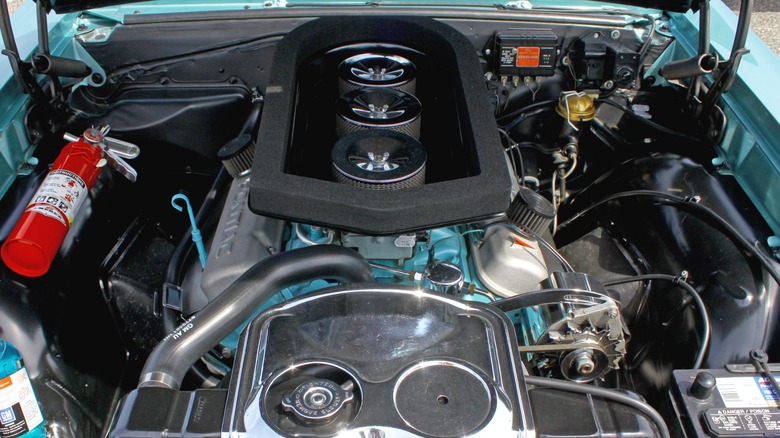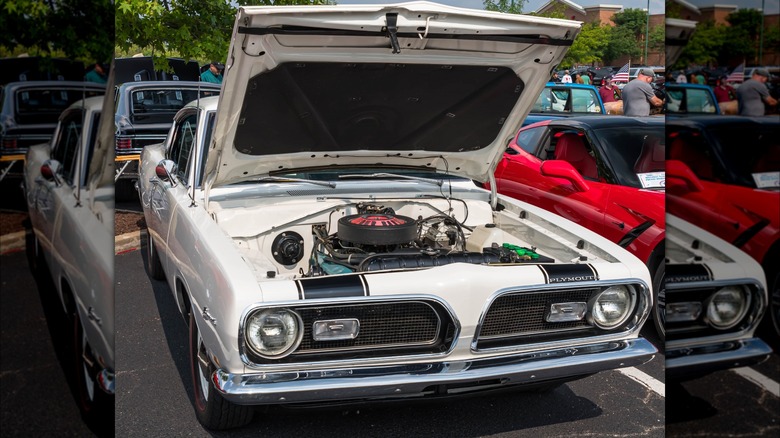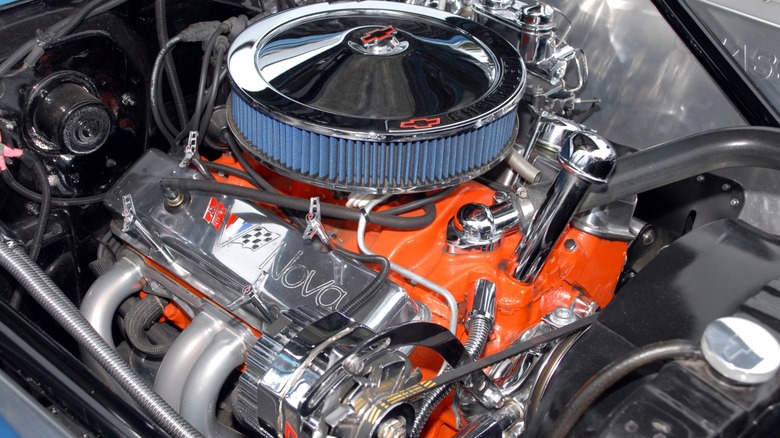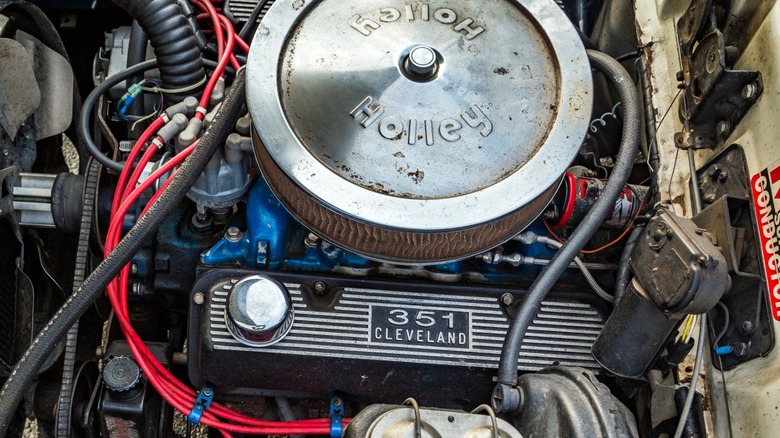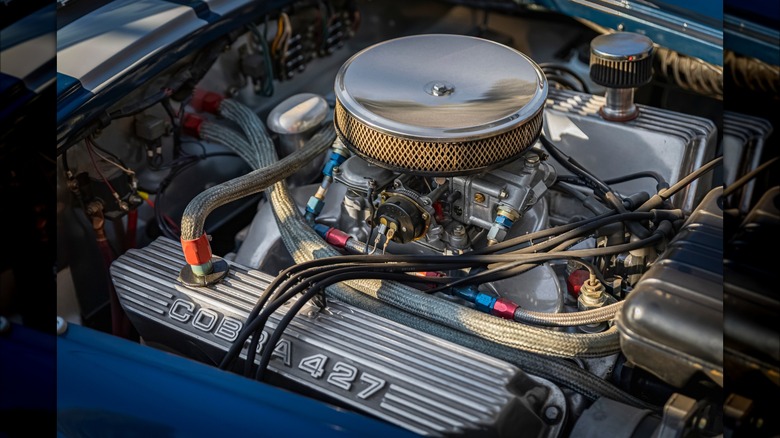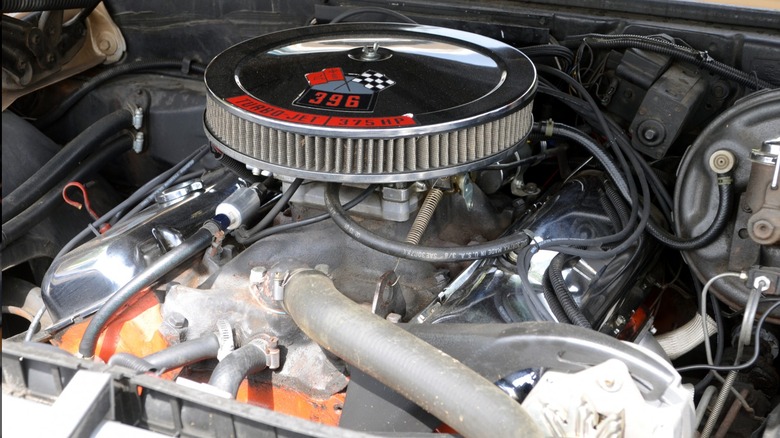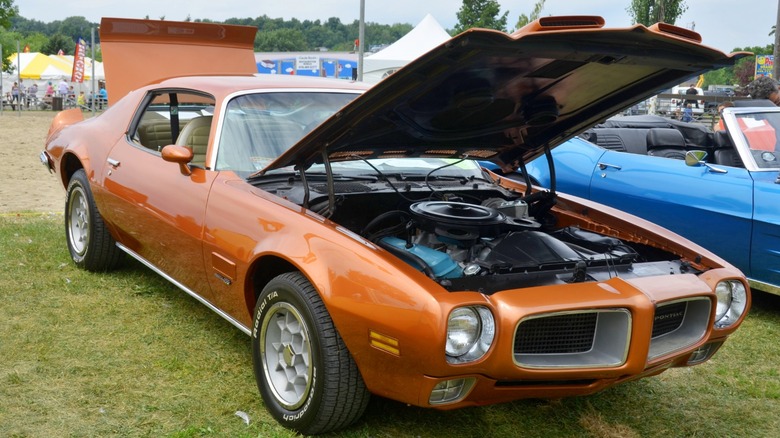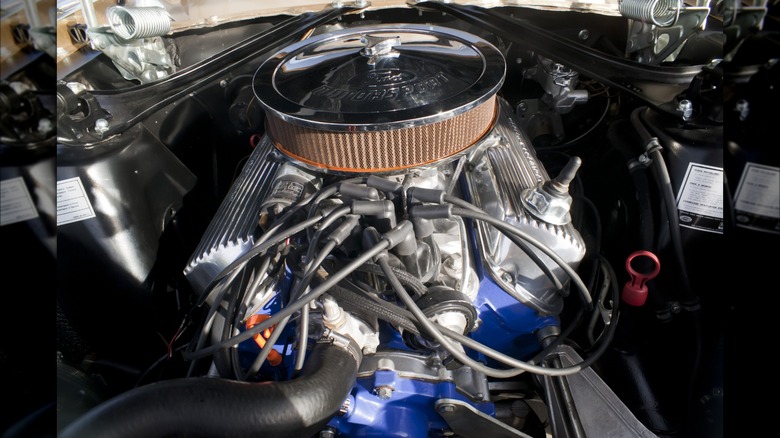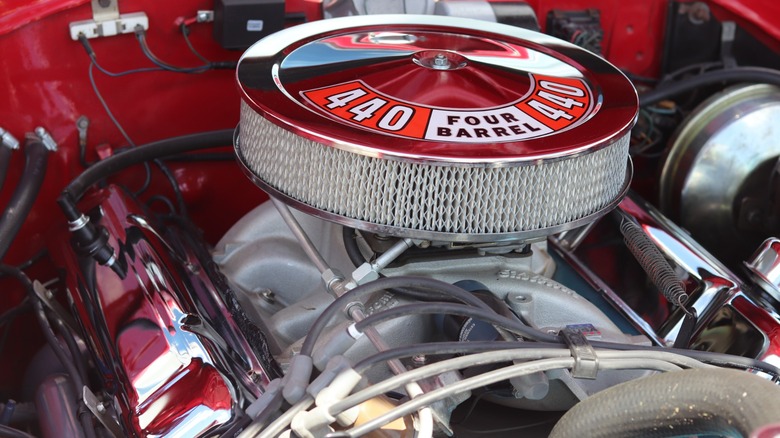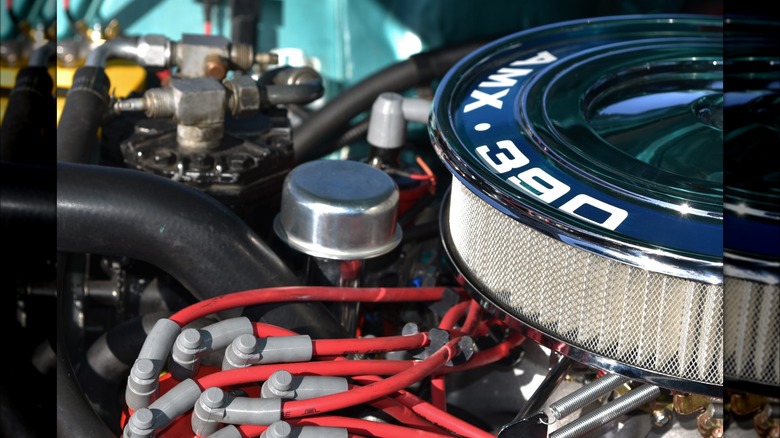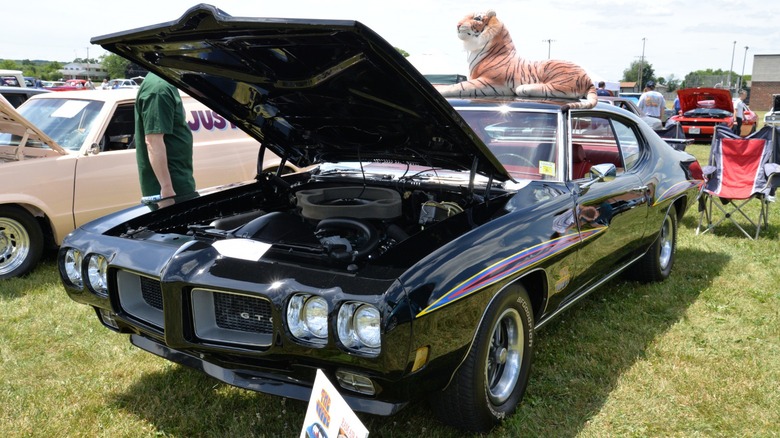Most Iconic Engines From The Golden Era Of Muscle Cars
The muscle car era unofficially kicked off in 1964 with the introduction of the Pontiac GTO, ultimately becoming one of the most popular segments of cars that are fast and attainable by ordinary drivers. Besides being powerful and fast cars, they were often quite attractive.
High-performance cars started to become wildly popular after World War II as the American economy returned to normal prosperity and growth. Experience in building military equipment for a total war production schedule provided American industrial interests invaluable manufacturing skills to be put toward producing new products for consumers. With the additional earnings being brought home by returning soldiers, demand for fun and exciting machines skyrocketed.
The first of these performance cars included the Corvette, Thunderbird, and more exotic examples like the Mercedes-Benz SL300. However, at the same time, enthusiasts were hot-rodding ordinary models, demonstrating that there was a demand for fast cars that the average American could afford, too. The early '60s were primed for just such a car, and American manufacturers delivered legendary classics like the GTO, Chevelle, Charger, Javelin, and GSX. It was the heyday for the muscle car and it seemed to be unstoppable — at least until pollution issues led the government to force auto manufacturers to clean up their act in the early '70s.
That led to the end of the golden era of muscle cars, but we will always cherish these vehicles — here are the iconic engines that powered them.
Chrysler 426 HEMI
Chrysler's HEMI engine, first introduced in 1951, is the foundation for many of the greatest muscle cars of the '60s and many of the new generation of Chrysler muscle cars. Although Chrysler was not the first to make an engine with a hemispherical combustion chamber, it leaned into the design in its marketing in a way no other company has. This made it seem like an engineering design unique to Chrysler and uniquely better than the competition. Whether it was better or not, few would argue that HEMIs are not great engines.
The combustion chambers on these engines are dome-shaped, allowing for the spark plug to be installed directly in the center, allowing for a closer spark that more fully burns the air charge. This is accompanied by a domed piston and valves installed at an angle, giving HEMI engines their characteristically wide cylinder heads. It was the second generation of engines that made a name for Chrysler, being found in the most iconic Mopar engines of the day, including Chargers, Superbirds, Coronets, and so forth.
Perhaps the most popular engine from this group is the 426 Hemi. Although Chrysler also offered a 440 V8, the 426 HEMI made more power and was preferred by drag racers of the period. The 426 was first introduced in the Plymouth Belvedere specifically for NASCAR racing but quickly became a favorite among hot rodders everywhere until its demise in the early '70s.
Small Block Chevy
One of the most well-known and most produced engines to ever come from an American auto factory is the venerable Small Block Chevrolet V8. Debuting in 1955, the new Chevrolet V8 would prove to be an enduring, simple, and robust design. The foremost of the engineers' considerations when creating this engine was cost. It had to be cheap enough to produce in large quantities, which forced the team leads to find solutions and components that were simple and functional. Many ideas went into this engine that may not have been new, but the combination of rocker design, casting process, and lubrication created an engine that was a breakthrough innovation.
The new V8 was an instant success, and the early 265 V8 soon gave way to the 327 that powers some of the most cherished of today's classic American cars, such as the 1963 Corvette Stingray and 1964 Impala SS. The displacement was increased to 350 cubic inches in 1967 for the all-new Camaro, spreading throughout the Chevrolet range within a couple of years. This 350 V8 dominated the Chevrolet lineup into the new millennium and contributed to the more than 100 million units produced over its 60-year run.
Although Chevrolet still makes a small block V8, it is fundamentally different from the original. However, that first 1955 design continued in production with various upgrades and improvements until 1997 when a complete overhaul of the architecture gave us the esteemed LS. The SBC continues to be a mainstay of the hot rodding community as its plentiful and inexpensive parts combined with an inherently robust design ensures it will be the prime choice for hobbyists for the foreseeable future.
Ford 351 Cleveland
Ford Motor Company was a trailblazer when it first debuted the Ford Flathead V8 engine in the '30s. That 65-horsepower engine was the reliable and powerful engine choice for a generation, powering family cars, gangster outlaw rides, and military vehicles alike.
After its technology became outdated, Ford pressed on with new overhead-valve designs, eventually releasing its 351 cu-in V8 in 1969. Its introduction filled an empty slot that existed between its smaller 289/302 engines and the big block 390/428 models. The more common 351 Windsor, named for the Canadian plant where it was produced, came as an enlarged version of the 302 and powered millions of cars through the '70s and '80s. However, the 351 Cleveland, named for the location where it was built, was a different design altogether.
The Cleveland engine was designed with higher performance in mind and benefitted from having larger valves and a free-flowing head design. This resulted in an intermediate engine option that provided good performance without going to large displacement engines such as the 427. In early models, some 351 Cleveland-equipped cars could boast of having up to 300 horsepower with an even more respectable 385 ft-lb torque rating.
This engine found itself in some of the finest Ford performance cars of the early '70s, including the Boss 351, Mach 1 Mustangs, and the Cougar XR7. By 1974, the horsepower party was drawing to a close, and the Cleveland's heyday was too. It remained in production for a while longer, but its power was severely diminished.
Ford 427
There is an old saying that says, "There is no replacement for displacement." This is often true when discussing methods for increased engine output, especially in the 1960s — especially since many cars of the era were extraordinarily large and getting larger with each new model year. Large engines were offered to keep these lumbering machines up to speed but also to unleash vast amounts of torque on the streets. Among Ford's most famous big block engines is its 427 V8, and the most infamous example of it happened when Carroll Shelby managed to squeeze the giant engine into the small and lightweight AC Cobra.
The 427 came from the early muscle car era and could be found in some of the best of Ford's intermediate-sized cars like the Galaxie, Fairlane, and Torino. These were models that raced in NASCAR, which allowed for a maximum engine size of 427 cubic inches.
Cars could be ordered with this engine featuring a dual-quad carburetor setup with a power output of 410 horsepower and 480 lb-ft of torque, more than enough to push these heavy machines down a drag strip. The aforementioned Cobra 427 could accelerate from 0 to 100 mph and then back to zero in just 14.5 seconds. However, perhaps an even better example is the notorious Ford GT — the machine that finally saw Ford beat Ferrari at LeMans.
Chevrolet 396
By the mid-'60s, Chevrolet already offered its 409 and 427 engines for customers who wanted more torque for their intermediate and large cars. However, starting in 1965, Chevrolet offered the 396 as a high-performance engine option for its intermediate and smaller muscle cars. That meant you could order the SS 396 versions of a Nova, Camaro, Chevelle, or El Camino from 1965 to 1970, and these are now some of the most sought-after versions of these cars.
The SS 396 V8 is good at making lots of power, often deceptively. For the 1966 to 1970 models, Chevrolet publicly published its power output of 375 horsepower. However, investigative journalists at publications such as Hot Rod found the actual numbers to be closer to 425 horsepower with torque shooting up to 445 lb-ft. It was also found during these tests that swapping the factory exhaust manifolds for a set of tuned headers could easily push the horsepower up to 457 and torque to an extremely healthy 464 ft-lb. The modified rating came from a cheap and easy swap of the exhaust and showed the potential to increase output to surpass even Chevy's own 454 V8.
Production of these mills ended in 1970, avoiding being choked to death by regulations and unceremoniously left on the vine to wither. Still, this means they are harder to come by today and those original SS 396 cars are prized possessions of collectors everywhere.
Pontiac Super Duty 455
Pontiac's 455 Super Duty — aka 455 High Output — came late in the golden era for muscle cars and was nearly the largest V8 engine ever offered in a passenger car, although the behemoth Cadillac 500 takes that title. The first Pontiacs with this giant engine appeared in the 1970 model year lineup, when the output of the 455 reached 370 horsepower with up to 500 ft-lb of torque, meaning this beastly engine could launch even the heaviest cars. It was used in full-size family cruisers like the Bonneville and Catalina, but it was most exciting in muscle cars.
The most memorable of the early '70s Pontiac models were the Super Duty LeMans, GTO, and the Firebird, including the Trans Am. The early ones were the torque monsters with massive power, but that changed within the first year and declined every year following. By the time the engine was discontinued, horsepower had fallen to just 200 in the Trans Am — a sad showing for such a beautifully styled and iconic car.
The muscle car era closed in 1974, but Pontiac managed to fool regulators at the EPA with a cheat, not unlike the VW cheat that brought Dieselgate. New regulations mandated manufacturers to add an EGR valve to all new engines. The testing regimen for this device lasted 50 seconds, so Pontiac engineers made their solenoid keep it activated for 53 seconds, thus allowing a more powerful — but polluting — engine on the market. However, regulators got wise to this and forced Pontiac to correct the issue, making the 1974 Trans Am Super Duty one of the last true muscle cars.
Ford Windsor 5.0
For decades, one engine dominated Ford's high-performance lineup of cars — the 5.0 V8. While also found on a variety of family wagons, cop cars, and ½-ton trucks, it remained the mainstay for Mustang power throughout the '80s and '90s. However, it has roots in the late '60s when it was introduced as an engine choice for the Mustang, among others. When the Mustang first emerged, it could be ordered with an excellent 289 V8 engine. After several years it was enlarged, leading to the 1968 debut of the Ford 302, which would continue in production for several decades.
The 302 initially came in its base form with a two-barrel carburetor producing 210 horsepower, moderate yet adequate for the time, but it saw a precipitous decline shortly thereafter. By 1977, horsepower was down to just 134. Despite these mostly lackluster performance figures, there were a couple of highlights.
In its debut year, Ford released the 302 in its high-performance Shelby GT350 Mustang. In this package, the V8 produced 250 horsepower, although the previous year's 289 made 306. The lower power issue was rectified in 1969's Boss 302 Mustang. This new homologation special featured a 302 making a much better 290 horsepower officially, though some who tested it say it was closer to 314.
The 302 ended up being a hugely successful engine that survived the power-starved years of the '70s. It powered dozens of Ford models and became the engine of choice for the Mustangs that would rule the streets again in the '90s.
Chrysler 440
When Chrysler introduced its 440 V8 in 1966, it was among the biggest engines found in passenger cars at the time. It may not have had the cultural cache and prestige of the popular HEMI engines, but it was easier and cheaper to produce, offering consumers an affordable way to get loads of power.
Also called the Chrysler wedge engines due to the way their combustion chambers are shaped, a Charger or Challenger with the 440 delivered 375 horsepower and, due to its huge displacement, an enormous amount of torque. This engine could be ordered in various configurations, but the highest performing was the six-pack, which came with a trio of two-barrel carburetors, often topped with an air scoop poking out of the hood.
Some of the most desirable cars equipped with the 440 include the Challenger, Barracuda, and Charger. British boutique automaker Jensen imported the huge V8 engines with Torqueflite transmissions for its luxury GT cars that were sold in a land where 2.0-liter engines were the norm –- the 440 is 7.2 liters.
The 440 continued in production through the implementation of EPA regulations and lost considerable power as did the engines of other automakers. Most 440s were relegated to truck duty in this period, although it could also be found in the land barges of the day, such as the nearly 20-foot Imperial LeBaron. Chrysler adapted to the 440 in 1977 its new Lean Burn technology, which used primitive electronics to control spark timing and fuel mixture but proved to be highly problematic. Production of the engine ended the following year, another victim of efforts to clean up our cities' air.
AMC 390
Always standing in the shadows of Detroit's Big Three, the American Motors Corporation had to work with smaller budgets and fewer resources to develop cars that the buying public might be interested in. For many years, the company accomplished this and even built some fantastic models that were stellar not just in comparison to the others but in their own right. The muscle cars coming from the AMC offices include the Rebel Machine, SC/Rambler, Javelin, AMX, and short-lived Marlin.
The most unique among the pony cars is the AMX, which has the distinction of being the only one with just two seats. It also has a shorter wheelbase than comparable cars but can get going thanks to its AMC 390 V8. Despite being available across the range, this engine became widely known simply as the AMX 390. AMC also did well with special editions, such as the smaller 1969 Hurst SC/Rambler. This came with the 390 making 315 horsepower while suppling prodigious torque through its 4-speed gearbox setup with a Hurst racing shifter. The 1970 Rebel Machine received the same 390 tuned up to 340 horsepower and 430 lb-ft of torque.
AMC was an interesting company making cars that punched well above their weight. The 390 proved to be a tough engine that could be tuned to make an abundance of power. For collectors, they remain affordable and still have a fervent fan base, making them fan favorites always at car shows.
Pontiac 400
John DeLorean is widely credited with kicking off the muscle car era with the 1964 GTO. His fingerprint on the auto industry goes much deeper than that, as he was also instrumental in launching the Firebird, specifically in taking the platform for the Camaro and making it uniquely Pontiac. What was also uniquely Pontiac were the engines. Broad parts sharing among divisions had not yet become the norm at GM, so the 350 in the Camaro would not be found in the Firebird. The top choice for it was the Pontiac 400 V8, a brilliant engine that had been powering GTOs and LeMans as a 389 for several years.
Starting in 1967, Pontiac offered its 400 V8 in several models. Pontiac was clever in packaging this engine with a bevy of options that allowed customers to order it with increasing levels of power. At the time, Pontiac differentiated itself from the other divisions by having a well-developed option palette from which to choose and allowing customers some degree of flexibility in creating something of a bespoke automobile.
One of the most popular option packages was The Judge, a GTO that could be had with the 400 V8 and a Ram Air package producing 370 horsepower. The same package in the Firebird was good for 345. Both of these figures are at the higher end of the era and part of why Pontiacs from this time are so beloved. The power of the 400 started dropping after 1972, and by 1980, Pontiac dropped anything over 350 cubic inches.
